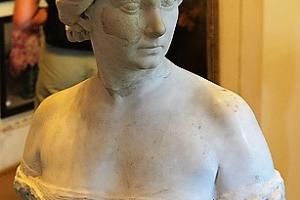Through the narrow entry, the visitor arrives at a rather magnificent hall with ornate columns. All around the walls we see paintings, the Burst of Varkocs by Dezső Raksányi among them. The topic of this picture is one of the sad events from the history of Székesfehérvár. In 1543, Sultan Sulejman arrived in the medieval Hungary with an enormous army to occupy one of the most important towns of the country that was the crowning and burying place of our kings. Captain György Varkocs burst out leading his cavalry to disturb the enemy with his sudden attack. However, when he wanted to return to the safety of the town’s strong walls, the people closed its gates and just watched as the dreadful preponderance massacred the heroes. They cowardly believed that if they hand over the town to the Turks voluntarily and without resistance, their lives and possessions would be saved. But the fee of the treason was a well-deserved and bitter disappointment.
In front of the window, the Wrestlers made from “pirobazalt” draws our attention. The two fighting figures show anger towards each other not only in their gestures but also in their expressions. Representing such unrestrained anger mainly appears in the works of secessionist artists and is very scarce in Bory’s art. When shaping his statues he rather tried to create peace and the classical balance of motions.
We specially have to mention the material of the Wrestlers. This cheap pirobazalt is deceptively similar to bronze which was expensive and very hard to find after the war. It is burnt potstone with a metallic outer shine and also their weight was very much alike. It is practically Bory’s own invention and as he made this material suitable for preparing statues he regularly used it in his works since the 1920s. “… how unfailingly pirobazalt, this improved black material which we just call Bory-bonze, serves the emergence of sculptor work. - he wrote it himself – Besides, the colour of burnt potstone shows so many fantastic ways of using it!” –And he is right. It’s enough just to take a look at the black Kossuth head (1922) or the absolutely different Self-portrait (1921) both found in the same room as the Wrestlers.
We meet one of Jenő Bory’s most frequent and most lovable model: the white marble bust of his wife (1927) that was carved with sensitivity, attention and confidence. Near to it we can see another beautiful marble portrait called Genovéva (Katica Savanyú 1922).
And why is this room called fireplace room? It was named after the beautiful Bory fireplace that was planned by Jenő Bory and cast in his brother Pál Bory’s workshop. The elaboration of the tunnels allowed very effective heating. They could even cook on the middle part and get warm on the seats on its side. There are two such fireplaces in the castle, one in the studio gallery and the other in the dining room of the flat museum.




